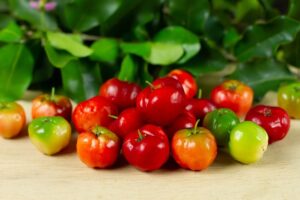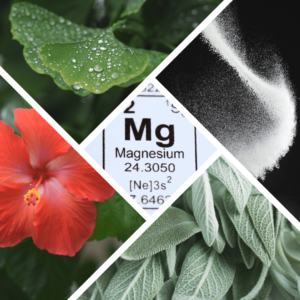This unique blend combines natural ingredients of Aloe vera, D-mannose, Olive leaf extract, Pear extract, Turmeric, DigeZyme® digestive enzyme blend, Fermented soy bean extract and black pepper extract to support urinary tract health and reduce the need for antibiotics.
Aloe vera
Aloe vera exhibits antioxidant effects [1] and the ability to modulate the immune system [2]
Aloe vera has shown antimicrobial activity against various bacteria, viruses, and parasites. It also has prebiotic potential, promoting the growth of beneficial gut bacteria which may also promote a healthy vaginal microbiome [3].
D-mannose
D-mannose, a simple sugar, is showing promise as a potential treatment for recurrent urinary tract infections (UTIs) [4]. It works by preventing bacteria, primarily E. coli, from adhering to the urinary tract lining [7]. Studies have shown that D-mannose can reduce the recurrence of UTIs, improve quality of life, and extend UTI-free periods [5]. These benefits contribute to an overall improvement in the quality of life for individuals suffering from recurrent UTIs [6]. D-mannose is well-tolerated with minimal side effects and represents a potential non-antibiotic approach to UTI prevention and management [4].
Olive leaf extract
Olive leaf extract leads to a significant decrease in the inflammatory cytokines IL-6, IL-8, and TNF-alpha indicates a reduction in inflammation and potentially improved immune function. This decrease may lead to reduced symptoms [8]. It has also been found to protect against oxidative stress [9,10].
Pear Extract
Pears are a rich source of bioactive compounds, including quercetin, which has been shown to exhibit several potential health benefits. Notably, quercetin demonstrates anti-inflammatory activity by suppressing neutrophil activity and the activation of NLRP3 inflammasomes [13, 14]. In addition it has antioxidant properties that protect cells from oxidative stress and free radicals [12]. Additionally, quercetin demonstrates antifungal activity against various fungi, including Candida albicans, the causative agent of thrush [11].
Turmeric
Turmeric is a potent anti-inflammatory and antioxidant, which can help with pain relief, promote immune function, and protect against cellular damage. For Full article click here
DigeZyme®
This digestive Enzyme Blend (providing Protease [15], Amylase [16], Lipase [17], Lactase [18] & Cellulase [19]) 40mg. DigeZyme® can be beneficial for individuals who experience digestive issues, such as bloating, gas, or discomfort after meals. It can also be helpful for individuals with specific dietary needs, such as lactose intolerance or difficulty digesting certain types of food.
Fermented Soy Bean Extract
This extract contains an enzyme called Nattokinase which is able to disrupt biofilms [20] and has been shown to be active against Staphylococcus Aureus. Nattokinase may help disrupt the biofilm of Staphylococcus saprophyticus (a closely related species) which is a common cause of UTI in younger women [21].
Black pepper extract
Black pepper enhances nutrient absorption, acts as an antioxidant, and may have anti-inflammatory properties. For more information click here
References
- Wang H.C., Brumaghim J.L. Oxidative Stress: Diagnostics, Prevention, and Therapy. American Chemical Society; Washington, DC, USA: 2011. Polyphenol compounds as antioxidants for disease prevention: Reactive oxygen species scavenging, Enzyme regulation, and metal chelation mechanisms in E. coli and human cells; pp. 99–175.
- Ahluwalia B., Magnusson M.K., Isaksson S., Larsson F., Öhman L. Effects of Aloe barbadensis Mill. extract (AVH200®) on human blood T cell activity in vitro. J Ethnopharm. 2016;179:301–309. doi: 10.1016/j.jep.2016.01.003.
- Sánchez M, González-Burgos E, Iglesias I, Gómez-Serranillos MP. Pharmacological Update Properties of Aloe Vera and its Major Active Constituents. Molecules. 2020 Mar 13;25(6):1324. doi: 10.3390/molecules25061324. PMID: 32183224; PMCID: PMC7144722.
- Cooper TE, Teng C, Howell M, Teixeira-Pinto A, Jaure A, Wong G. D-mannose for preventing and treating urinary tract infections. Cochrane Database Syst Rev. 2022 Aug 30;8(8):CD013608. doi: 10.1002/14651858.CD013608.pub2. PMID: 36041061; PMCID: PMC9427198.
- Kyriakides R, Jones P, Somani BK. Role of D-Mannose in the Prevention of Recurrent Urinary Tract Infections: Evidence from a Systematic Review of the Literature. Eur Urol Focus. 2021 Sep;7(5):1166-1169. doi: 10.1016/j.euf.2020.09.004. Epub 2020 Sep 22. PMID: 32972899.
- De Nunzio C, Bartoletti R, Tubaro A, Simonato A, Ficarra V. Role of D-Mannose in the Prevention of Recurrent Uncomplicated Cystitis: State of the Art and Future Perspectives. Antibiotics (Basel). 2021 Apr 1;10(4):373. doi: 10.3390/antibiotics10040373. PMID: 33915821; PMCID: PMC8066587.
- Wawrysiuk S, Naber K, Rechberger T, Miotla P. Prevention and treatment of uncomplicated lower urinary tract infections in the era of increasing antimicrobial resistance-non-antibiotic approaches: a systemic review. Arch Gynecol Obstet. 2019 Oct;300(4):821-828. doi: 10.1007/s00404-019-05256-z. Epub 2019 Jul 26. PMID: 31350663; PMCID: PMC6759629.
- Javadi H, Yaghoobzadeh H, Esfahani Z, Reza Memarzadeh M, Mehdi Mirhashemi S. Effects of Olive Leaf Extract on Metabolic Response, Liver and Kidney Functions and Inflammatory Biomarkers in Hypertensive Patients. Pak J Biol Sci. 2019 Jan;22(7):342-348. doi: 10.3923/pjbs.2019.342.348. PMID: 31930845.
- Chiaino E., Micucci M., Cosconati S., Novellino E., Budriesi R., Chiarini A., Frosoni M. Olive leaves and hibicus flowers extracts-based preparation protect brain from oxidative stress-induced injury. Antioxidants. 2020;9:806. doi: 10.3390/antiox9090806.
- Singh I., Mok M., Christensen A.M., Turner A.H., Hawley J.A. The effects of polyphenols in olive leaves on platelet function. Nutr. Metab. Cardiovasc. Dis. 2008;18:127–132. doi: 10.1016/j.numecd.2006.09.001.
- Wang G., Wang Y., Yao L., Gu W., Zhao S., Shen Z., Lin Z., Liu W., Yan T. Pharmacological Activity of Quercetin: An Updated Review. Evid.-Based Complement. Altern. Med. 2022;2022:3997190.
- Xu D., Hu M.-J., Wang Y.-Q., Cui Y.-L. Antioxidant Activities of Quercetin and Its Complexes for Medicinal Application. Molecules. 2019;24:1123. doi: 10.3390/molecules24061123.
- Tanaka Y. Inflammation and Regeneration Rheumatoid Arthritis. BioMed Cent. 2020;40:1–8.
- Wang G., Wang Y., Yao L., Gu W., Zhao S., Shen Z., Lin Z., Liu W., Yan T. Pharmacological Activity of Quercetin: An Updated Review. Evid.-Based Complement. Altern. Med. 2022;2022:3997190. doi: 10.1155/2022/3997190.
- Protease: Aids in the digestion of proteins, breaking them down into smaller peptides and amino acids for absorption. This can be beneficial for individuals who experience difficulty digesting protein-rich foods.
- Amylase: Helps break down carbohydrates, such as starches and sugars, into simpler sugars that the body can use for energy. This can be helpful for individuals who experience bloating or discomfort after consuming carbohydrate-rich meals.
- Lipase: Aids in the digestion of fats, breaking them down into fatty acids and glycerol for absorption. This can be beneficial for individuals who experience difficulty digesting fatty foods.
- Lactase: Helps break down lactose, the sugar found in dairy products. This is essential for individuals with lactose intolerance who experience digestive issues after consuming dairy.
- Cellulase: Aids in the breakdown of cellulose, a type of fiber found in plant cell walls. While humans cannot digest cellulose, cellulase can help break it down into smaller components, potentially aiding in the digestion of fiber-rich foods.
- Kimijima M, Narisawa N, Hori E, Mandokoro K, Ito T, Ota Y, Sashida M, Kawai Y, Takenaga F. Nattokinase, a Subtilisin-like Alkaline-Serine Protease, Reduces Mutacin Activity by Inactivating the Competence-Stimulating Peptide in Streptococcus mutans. Pathogens. 2024 Mar 27;13(4):286. doi: 10.3390/pathogens13040286. PMID: 38668241; PMCID: PMC11054032.
- Hogan S, O’Gara JP, O’Neill E. Novel Treatment of Staphylococcus aureus Device-Related Infections Using Fibrinolytic Agents. Antimicrob Agents Chemother. 2018 Jan 25;62(2):e02008-17. doi: 10.1128/AAC.02008-17. PMID: 29203484; PMCID: PMC5786758.



